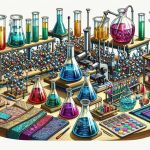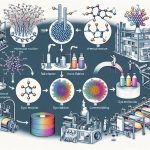When you think about the clothes you wear, you might not immediately consider the chemistry behind them, but it's essential. From creating synthetic fibers to treating natural ones, chemistry shapes every step of fabric production. It's involved in polymerization, which transforms monomers into polymers, and plays a key role in dyeing techniques that give fabrics their vibrant colors. Beyond aesthetics, chemistry enhances fabric durability and provides treatments that resist stains. With ongoing advancements, eco-friendly innovations and smart fabrics are reshaping the textile industry. So, how exactly does chemistry make your favorite sweater both stylish and sustainable?
Table of Contents
Key Takeaways
- Polymerization processes create synthetic fibers by transforming monomers into polymers.
- Chemical treatments enhance fabric properties like stain resistance, durability, and performance.
- Dyeing techniques use natural and synthetic dyes to achieve desired fabric colors.
- Eco-friendly innovations focus on sustainable chemical processes and renewable materials.
- Smart fabrics utilize advanced technologies, including nanotechnology, for enhanced functionalities.
Synthetic Fiber Creation
How do chemists transform raw materials into the synthetic fibers that make up so many of our everyday textiles?
You begin by understanding the core process of polymerization. Chemists take monomers—small, repeating molecular units—and chemically bond them to create long chains known as polymers. These polymers are the backbone of synthetic fibers like nylon, polyester, and acrylic.
To enhance fiber strength, you need to pay attention to the molecular structure.
High tensile strength is achieved by aligning the polymer chains in a parallel arrangement. This alignment, often done through stretching or drawing the fibers, increases the material's durability and resistance to wear and tear. Ensuring uniformity in this process is essential for producing high-quality synthetic fibers.
However, you can't ignore the environmental impact of synthetic fiber production.
The process often involves petrochemicals, and the resulting fibers are non-biodegradable, contributing to long-term waste. You can mitigate these effects by researching and developing more sustainable alternatives, such as bio-based polymers or recycling existing synthetic fibers. By improving the efficiency and sustainability of these processes, you contribute to a more environmentally friendly textile industry while maintaining the desired fiber strength and quality.
Natural Fiber Treatment
Mastering the art of natural fiber treatment involves understanding the unique characteristics of each fiber type, from cotton to wool. You need to contemplate fiber sustainability and the environmental impact of the treatments you choose. By opting for organic treatments, you can enhance fiber quality while minimizing ecological harm. For instance, organic enzymes can be used to soften cotton fibers, ensuring they remain pliable without harmful chemicals.
Utilizing organic treatments not only supports sustainability but also improves color retention, maintaining the vibrancy of natural fibers. Wool, for example, benefits from mild acidic washes that preserve its natural luster and elasticity. Understanding these treatment techniques will empower you to achieve superior results.
Here's a quick reference table to guide your treatment choices:
| Fiber Type | Preferred Organic Treatment |
|---|---|
| Cotton | Organic enzymes |
| Wool | Mild acidic washes |
| Linen | Natural pectin removal |
| Hemp | Biodegradable softeners |
| Silk | Gentle protease enzymes |
Polymerization Process
When you explore the polymerization process, you'll see how monomers link together to form polymers, the building blocks of synthetic fabrics.
Catalysts play a critical role in speeding up these reactions and ensuring efficiency.
Understanding these elements helps you grasp the chemistry behind fabric production.
Monomers to Polymers
The transformation from monomers to polymers, known as the polymerization process, is a fundamental chemical reaction in fabric production. You need to grasp the intricacies of polymerization mechanisms and chemical bonding techniques to truly master this topic.
Polymerization mechanisms, such as addition and condensation, determine how monomers link together. In addition polymerization, monomers like ethylene join through the breaking of double bonds, forming long chains without producing by-products. Condensation polymerization, on the other hand, involves monomers like nylon, which bond while releasing small molecules, often water.
Understanding chemical bonding techniques is vital. Covalent bonds, where atoms share electrons, are the backbone of polymer chains. Techniques like free-radical polymerization utilize initiators to create reactive sites on monomers, facilitating the chain reaction that forms polymers. Ionic polymerization, another method, depends on charged species to propagate the reaction.
Mastery of these techniques allows you to manipulate polymer properties, creating fabrics with specific characteristics like elasticity, strength, or durability.
Catalysts in Polymerization
Catalysts play an integral role in speeding up polymerization reactions, allowing you to produce polymers more efficiently. By lowering the activation energy required for the reaction, catalysts enhance both the rate and selectivity of polymer formation. This means you can achieve higher catalyst efficiency, resulting in more consistent product quality and reduced energy consumption.
Understanding reaction kinetics is vital for mastering polymerization processes. Kinetics involves studying the rates at which chemical reactions proceed and how various factors—like temperature, pressure, and catalyst type—affect these rates. When you optimize these variables, you enhance catalyst efficiency, ensuring the polymerization process is both fast and controlled.
Using catalysts, you can tailor-make polymers with specific properties suited for various fabric applications.
For instance, Ziegler-Natta catalysts are widely used to produce high-density polyethylene, a material prized for its strength and durability. Similarly, metallocene catalysts allow for the creation of polymers with unique molecular architectures, offering greater flexibility and functionality.
Dyeing Techniques
In exploring dyeing techniques, you'll see a mix of time-honored natural dye processes and modern synthetic dye innovations.
Natural dyes, often derived from plants and insects, offer unique colors and environmental benefits.
On the other hand, synthetic dyes provide a vast range of vibrant hues and improved durability.
Natural Dye Processes
Exploring natural dye processes reveals how plant-based pigments can transform fabric in vibrant and sustainable ways. You'll find that using natural dyes doesn't just produce rich, unique colors; it also aligns with eco-friendly practices, reducing chemical waste and pollution.
By harnessing the hues from plants, roots, and even insects, you can create a stunning array of colors while supporting sustainability.
Traditional techniques play a pivotal role in this process. Methods such as immersion dyeing, where fabrics are soaked in dye baths made from boiled plant materials, have been used for centuries. These age-old techniques have been adapted for modern applications, allowing you to achieve consistent and lasting colors without sacrificing environmental benefits.
Whether you're working with indigo for deep blues or madder root for vibrant reds, the possibilities are endless.
Moreover, the integration of modern technology with traditional methods allows for precise control over the dyeing process. You can now measure temperature and pH levels to guarantee optimal color absorption and fastness.
Synthetic Dye Innovations
With advancements in synthetic dye innovations, you can now achieve a broader spectrum of colors with greater efficiency and consistency. Modern techniques have revolutionized textile innovation, enabling the creation of sustainable pigments that not only enhance color vibrancy but also improve color fastness. These improvements guarantee that your fabrics retain their brilliant hues even after multiple washes, addressing a common issue in traditional dyeing processes.
To give you a clearer understanding, here's a comparison of traditional and modern synthetic dye techniques:
| Aspect | Traditional Dyes | Modern Synthetic Dyes |
|---|---|---|
| Color Range | Limited | Extensive |
| Efficiency | Time-consuming | Highly efficient |
| Sustainability | Often uses harmful chemicals | Utilizes sustainable pigments |
| Color Fastness | Prone to fading | Superior color fastness |
One of the key benefits of these innovations is the ability to produce vibrant and durable colors without compromising environmental standards. Advanced dyeing techniques now focus on reducing water usage and minimizing waste, making the process more eco-friendly. By mastering these modern methods, you can guarantee your textiles meet both aesthetic and sustainability goals, setting a new standard in the industry.
Fabric Finishing
Fabric finishing involves applying various chemical treatments to enhance the texture, appearance, and performance of the final product.
You can achieve fabric softening through the use of specific chemicals that impart a smoother, more pliable feel to textiles, making them more comfortable to wear.
Additionally, wrinkle resistance is a sought-after property that can be achieved by treating fabrics with resins that help them maintain their shape and resist creasing.
But that's not all; modern fabric finishing goes beyond mere comfort and aesthetics.
Anti-microbial finishes play an essential role in creating textiles that inhibit the growth of bacteria and fungi, thereby enhancing the hygiene and longevity of the fabric.
These finishes are particularly vital for healthcare and athletic wear, where cleanliness is paramount.
Water repellency is another significant aspect of fabric finishing.
By applying hydrophobic coatings, you can make fabrics resistant to water penetration, which is invaluable for outdoor gear and rainwear.
This treatment helps keep you dry and comfortable in wet conditions without compromising the breathability of the fabric.
Mastering these finishing techniques allows you to produce high-quality textiles that meet the diverse needs of today's market, adding significant value to your fabric products.
Stain Resistance
When considering stain resistance in fabrics, you'll find that chemical coating techniques play an essential role. These coatings create a barrier that repels liquids and dirt.
Additionally, polymer blends enhance efficiency by providing a durable, long-lasting shield against stains.
Chemical Coating Techniques
Stain resistance in fabrics often hinges on advanced chemical coating techniques that repel liquids and prevent absorption. By mastering these techniques, you'll understand how chemical bonding and surface modification play pivotal roles.
Chemical bonding involves the interaction of fabric fibers with special chemicals, creating a protective layer. This layer doesn't just sit on the fabric; it integrates at a molecular level, forming robust bonds that enhance durability and efficacy.
Surface modification is another significant aspect. Here, you alter the fabric's surface to make it less hospitable to stains. Think of it as giving the fabric a new set of properties without changing its inherent characteristics. Techniques like plasma treatment or the application of fluorochemicals can make the fabric hydrophobic, meaning water and other liquids bead up and roll off rather than soaking in.
Polymer Blends Efficiency
Building on the protective measures achieved through chemical coatings, polymer blends offer another layer of efficiency in enhancing stain resistance.
By mastering blending techniques, you can create fabrics that not only repel stains but also improve overall durability. The key lies in understanding the material properties of different polymers and how they interact when combined.
When you blend polymers, you're looking to optimize the characteristics of each component. For instance, combining polyester with nylon can yield a fabric that's both strong and resistant to staining. The blending techniques involve precise control over the mixing process to make sure uniformity and effectiveness.
This isn't just about trial and error; it's about applying your knowledge of chemistry to predict how different polymers will behave together.
Moreover, these polymer blends can be engineered to resist specific types of stains, whether they're oil-based, water-based, or organic. By fine-tuning the blend, you can create a fabric that's tailor-made to meet the specific needs of various applications, from high-performance sportswear to elegant upholstery.
Durability Enhancements
Enhancing fabric durability involves incorporating advanced chemical treatments that greatly extend the material's lifespan. By using innovative chemical additives, you can improve fabric longevity to a high degree. These additives work by creating strong chemical bonds within the fibers, making them more resistant to wear and tear. This strength enhancement guarantees that your fabrics maintain their integrity even after repeated use and washing.
When you explore the science behind these treatments, you'll find that they often involve the application of resins or other bonding agents that penetrate deep into the fabric. These agents form cross-linked networks that strengthen the material's structural integrity. This isn't just about making the fabric tougher; it's about creating a balanced synergy where flexibility and strength coexist.
You'll also appreciate that these chemical treatments can be tailored to specific fabric types, ensuring the best performance for each material. Whether you're working with cotton, polyester, or blends, the right chemical bonding can make a noticeable difference in durability.
Eco-Friendly Innovations
When it comes to eco-conscious advancements in fabric production, leveraging sustainable chemical processes can diminish environmental impact to a large extent. By embracing sustainable practices, you can utilize renewable materials that are not only efficient but also kind to our planet. One significant advancement in this arena is the use of biodegradable alternatives for producing fabrics. These materials break down more naturally, leading to significant waste reduction.
Here's a quick comparison to highlight the benefits:
| Aspect | Traditional Methods | Eco-conscious Innovations |
|---|---|---|
| Raw Materials | Non-renewable sources | Renewable materials |
| Environmental Impact | High | Low |
| Waste Management | Significant waste | Waste reduction |
| Biodegradability | Low | High |
Smart Fabrics
Smart textiles are transforming the textile industry by integrating advanced technologies directly into the material. These innovative fabrics incorporate wearable technology, allowing for functionalities like health monitoring, temperature regulation, and even energy harvesting. Conductive textiles, made by embedding conductive materials such as silver or carbon fibers into the fabric, enable these smart features.
You can now wear clothing that doubles as a health monitor, providing real-time data on your essential signs.
Sustainability is another vital aspect of smart fabrics. By optimizing the production process and extending the lifespan of garments, these materials contribute to a reduction in environmental impact. For instance, smart textiles can be designed to resist wear and tear, reducing the need for frequent replacements and thereby cutting down on waste.
Additionally, some smart textiles are created using eco-friendly materials and processes, aligning with the growing demand for sustainable fashion.
Incorporating wearable technology into everyday clothing not only enhances convenience but also promotes a more sustainable lifestyle. As you explore the potential of smart fabrics, you'll find that they represent a significant advancement in both functionality and environmental consciousness, blending the best of modern science with responsible innovation.
Future of Fabric Chemistry
Imagine a future where fabric chemistry not only enhances the aesthetics of your clothing but also revolutionizes its performance and sustainability. As we stand on the cusp of groundbreaking sustainability advancements, chemical breakthroughs in fabric chemistry promise to transform the textile industry. You'll experience clothing that's not only stylish but also environmentally friendly, thanks to innovations such as biodegradable fibers and waterless dyeing techniques.
Technological advancements are driving this evolution. Imagine fabrics that adapt to temperature changes, wick away moisture more efficiently, or even repel stains without harmful chemicals. These smart textiles are becoming a reality through the integration of advanced polymers and nanotechnology. You're looking at a future where your clothing actively contributes to your comfort and well-being.
Moreover, the push for eco-friendly solutions is relentless. Researchers are developing methods to recycle old textiles into new, high-quality fabrics, markedly reducing waste. Chemical breakthroughs are also enabling the creation of materials from sustainable sources like algae and agricultural byproducts. By harnessing the power of fabric chemistry, you're not just wearing clothes; you're participating in a movement towards a more sustainable and technologically advanced world.
Frequently Asked Questions
How Does Chemistry Influence Fabric Texture and Feel?
You can't overlook how chemistry influences fabric texture and feel. Through chemical bonding, textile chemistry enhances fabric comfort and quality. Mastering these interactions guarantees you produce superior fabrics with the perfect balance of softness and durability.
What Chemical Processes Are Involved in Fabric Shrinkage Prevention?
Think of fabric as a puzzle. Just like you'd use glue for puzzle pieces, chemical bonding strengthens fabric. Fabric dyeing techniques utilize precise chemical reactions, ensuring shrinkage prevention while maintaining fabric strength and resilience.
How Do Chemical Treatments Affect Fabric Breathability?
You might find that chemical treatments can greatly affect fabric breathability. While they enhance fabric durability and moisture absorption, the chemical impact can sometimes reduce airflow, making the fabric less breathable. Balancing these factors is vital.
What Role Do Chemicals Play in Fabric Fire Resistance?
Did you know that flame retardant chemical additives can increase fabric durability by up to 50%? These chemical treatments make fabrics less flammable, ensuring enhanced safety without compromising their longevity or comfort.
How Is Fabric Softness Achieved Through Chemical Means?
To achieve fabric softness chemically, you treat the fibers with softeners that reduce friction. This not only enhances softness but also maintains fabric durability. Additionally, chemical treatments can impact fabric color, ensuring it remains vibrant.
- Why Open-Weave Scrim Is the Secret to Stunning Event and Canopy Designs - June 26, 2025
- Creating Large-Scale Art Installations With Scrim Fabric - June 26, 2025
- Scrim Fabric in Upholstery: Understanding Its Use as a Backing Material - June 26, 2025







